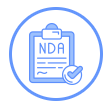The Pros and Cons of Nearshore vs. Offshore Dedicated Developers

The modern business landscape is highly digitized. Startups wanting to make their mark need the world’s best talent. The best way to access it is through software development outsourcing.
Firms offering outsourcing services have become valuable partners for businesses today. They enable startups to develop top-notch products swiftly. You no longer need to lag because of the absence of an in-house team.
There are two popular outsourcing options to choose from. These are nearshore software development and offshore development. Both differ greatly from each other. This guide will give you everything you need to know to make the right choice.
Over 70% of U.S. tech companies outsource software development. Outsourcing lets them expedite time to market and cut development costs by 40%!
What Is Nearshore Software Development?
In this model, businesses assign software development to teams in a nearby country. These nations usually have similar or the same time zones. For example, a company in the US will delegate its projects to Mexico. Canada will outsource it to Latin America.
This setup allows for smooth collaboration. It leads to process efficiencies when working with a remote team. Businesses use this model to leverage lower labor costs. It allows them to tap into global tech expertise. Companies wanting a specialized skill set that is unavailable in their country also use this model.
How Does Nearshore Development Work?
The nearshore model joins your team with skilled experts. There are fewer chances of issues arising due to time zones and cultural differences. Here’s how it works.
Needs Analysis
You identify your development needs and expectations from this model. These can be product requirements, and the timeframe, among others.
Choosing a Nearshore Software Development Company
Now, you select a partner based on your parameters. Selection is done based on the following:
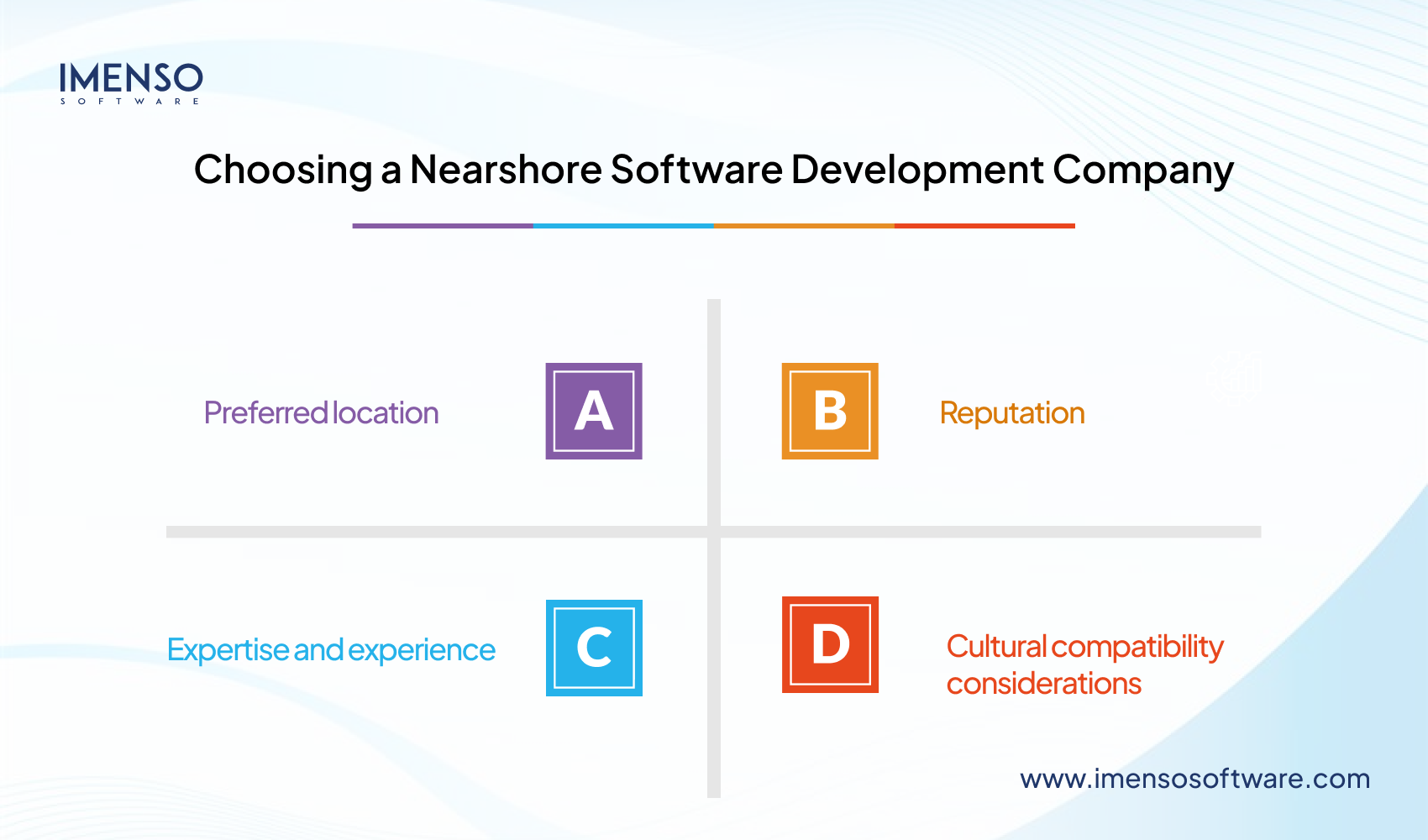
- Preferred location
- Reputation
- Expertise and experience
- Cultural compatibility considerations
Establishment of Cooperation Conditions
In this step, you work with your partner to define how you’ll work. This consists of defining the project scope and the team’s structure. It also includes how you’ll communicate and the timeframe.
Product Development
Your nearshore software development company will create the team based on your requirements. The team begins working on your product. They use a relevant project management approach for this purpose. The team works closely with you. You get regular updates and progress reports.
Assurance of Quality
The QA team tests the product on various criteria. These are
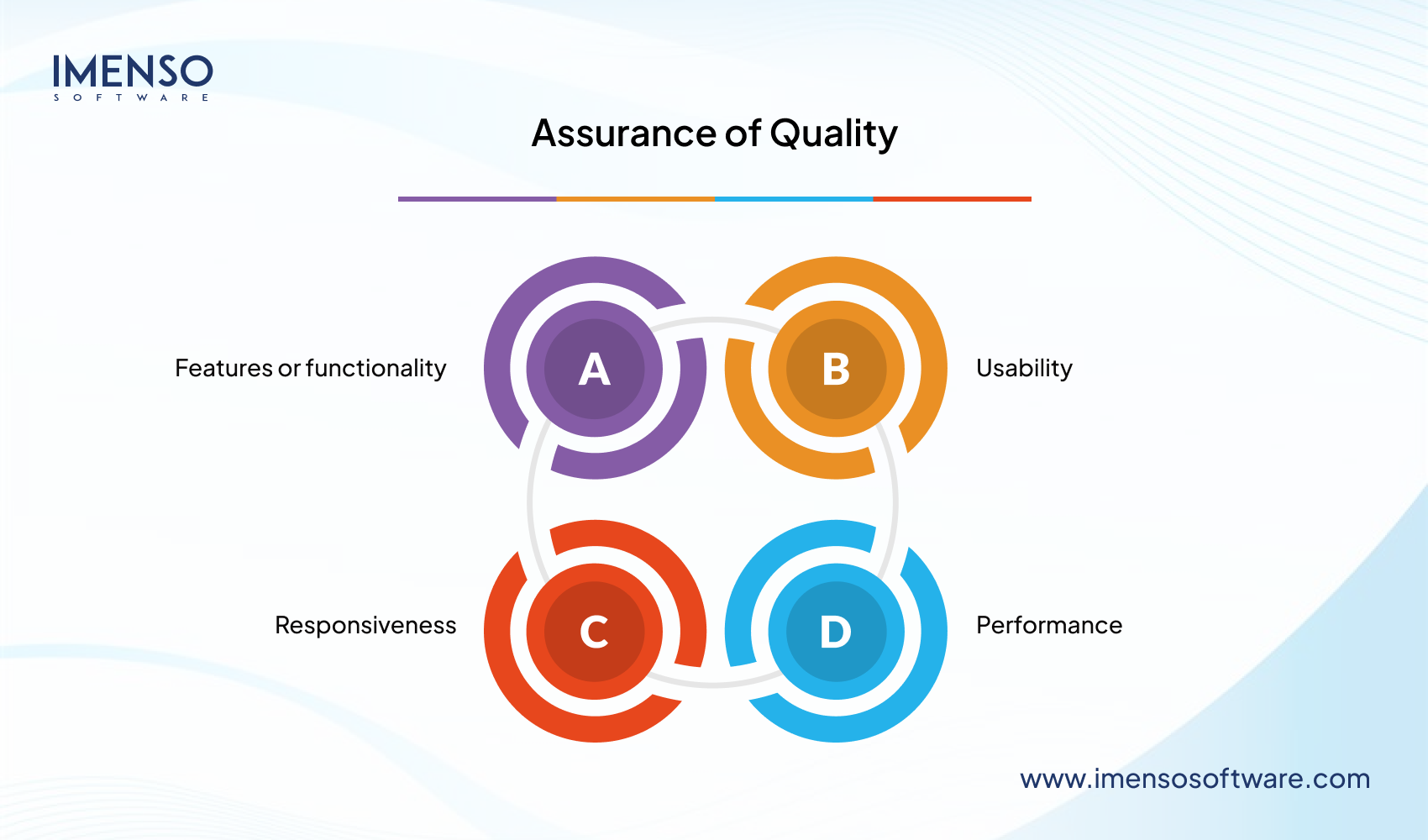
- Features or functionality
- Usability
- Responsiveness
- Performance
If they find any issues anywhere, they address them immediately.
Product Delivery and Support
The team delivers the software to you. They also offer support post-release. It ensures that the product works as intended over time.
US-based businesses seek nearshore talent because of a close workday overlap, good cultural fit, and strong English language proficiency.
When to Opt for Nearshore Software Development
To choose between nearshore vs. offshore, you must know the ideal situations for both. Below are the scenarios where the nearshore model works the best.
- You want software for B2B, B2C, and SaaS.
- Real-time collaboration is more crucial for you than face-to-face interaction.
- You want novel software solutions.
- For businesses using an Agile approach.
- You have a limited budget.
- You want to modernize legacy software solutions.
- Projects that require teamwork and real-time discovery.
Pros of Nearshore Development
This model offers various benefits to startups. These are:
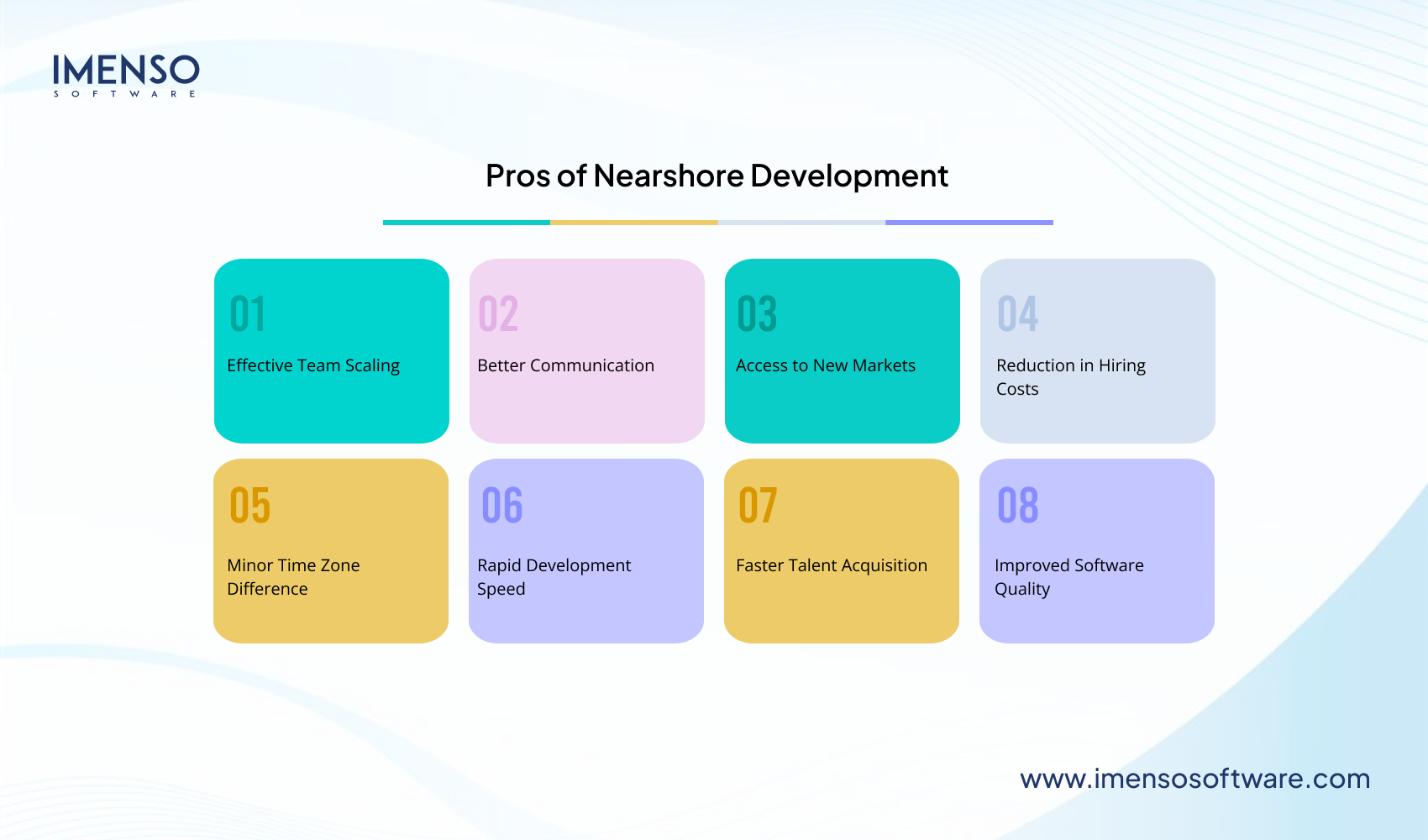
Effective Team Scaling
If you want to develop several apps over a period, nearshoring will be ideal. It lets you effectively manage and scale your team. You can easily adjust your team size depending on your needs. This is great for Agile teams with iterative cycles. You can cut costs by hiring teams only when necessary.
Better Communication
Nearshoring links you closer to the development teams. It eliminates the issue of communication gaps. This is one of the main areas of comparison between offshore vs. nearshore. You hire teams from nations closer to you. There is more cultural compatibility. The improved communication makes way for project success.
Access to New Markets
Nearshoring lets you expand into new markets. Nearshore teams are deeply familiar with local cultures and market conditions. This allows for a more targeted development. It also lets you tailor your marketing efforts to tap into new markets.
Reduction in Hiring Costs
Software development is expensive. So, getting a high-quality result is critical. Nearshoring is a cost-effective option for startups. You don’t have to hire and train new people. There’s no need to build more office space or pay extra wages. Nearshoring can save startups millions of dollars on a project. All this without any compromise in quality.
Minor Time Zone Difference
The time zone is another factor to consider when deciding between a nearshore vs. offshore model. Nearshoring does not pose any problems on this front. For example, Mexico is just two hours behind Washington, DC. The time zone gap is even smaller for central and western European nations. They are only an hour behind the US. This leads to scheduling meetings and working at a time when it’s convenient for everyone.
Rapid Development Speed
Software testing is a tedious process. It takes up most of the time of an in-house team. The nearshore model resolved this issue. It has dedicated software testers. They blend with your current team, enabling swift product launches.
Nearshore teams have defined work processes. They also have specialized expertise. You can scale your development by using a bigger talent pool. All of it leads to quicker time-to-market.
Faster Talent Acquisition
Nearshoring gives you access to a pool of skilled IT specialists. You don’t have to spend time on lengthy internal hiring. Nearshore software development companies form a team of dedicated developers for your project. They then integrate them with your in-house team, if you have one. Thus, you get a highly efficient workforce.
Improved Software Quality
The model allows for higher-quality product releases. This is because you tap into a wider talent pool of skilled IT specialists. They build your product using the best practices and tech stack. There’s also a shared cultural and language familiarity. This lowers the chances of miscommunication. It leads to fewer errors. Nearshore companies have strict testing rules. This results in robust solutions.
80% of businesses in North America are actively considering nearshore.
Source: Bloomberg
Cons of Nearshore Outsourcing
The model also has some risks. These are:
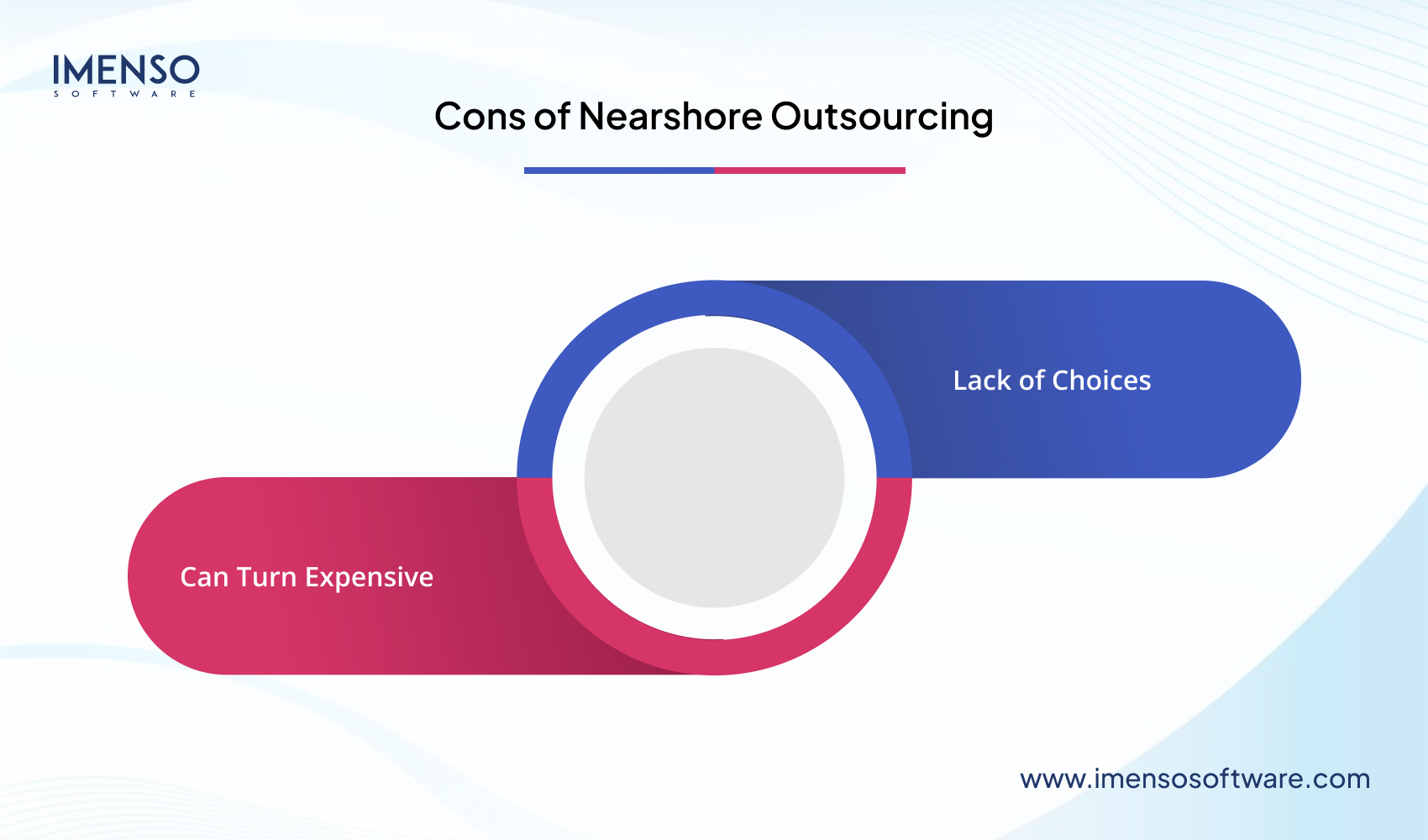
Can Turn Expensive
Hiring nearshore software development companies, especially in the West, can be more costly than offshoring to Eastern nations.
Lack of Choices
You don’t have many options in choosing the nations. There are only a handful of countries where you can consider. So, you might struggle to find something that meets your needs.
Successful Nearshoring Examples
Several companies have used nearshoring to achieve success. Here are some compelling examples.
Microsoft
Microsoft taps into the nearshoring potential of Latin America. Here, it is majorly nearshores to Mexico and Brazil. Nearshoring has led Microsoft to boost its development cycles. It has been able to offer better customer support. The company has also deployed cloud solutions more effectively. Nearshoring lets Microsoft stay close to new markets. It also stimulates quick innovation.
Oracle
Oracle, the cloud giant partners with IT companies in Eastern Europe. More specifically, it outsources to Poland and Romania. Both these places are technically proficient. IT specialists speak English fluently. This lets Oracle streamline development workflows. It also helps it improve service delivery.
SAP
SAP is the leader in enterprise software. Its nearshoring centers are Argentina and Mexico. SAP benefits from a skilled workforce in these regions. Developers here are deeply familiar with the latest tech stack. Nearshoring has allowed SAP to cut development costs. It has been able to offer robust support to the end users. The delivery of custom solutions by SAP can be attributed to its nearshoring strategy.
What Is Offshore Software Development?
In this model, startups hire a team from another country for their projects. For example, a tech startup in the US finds skilled developers in India. These experts can do the same job at a lower cost. The offshore model lets you tap into global talent. The talent isn’t limited to nearby nations. You don’t need to expand your in-house team.
The model is suited for when your local staff is working on other projects. You can hire a team in a distant country. They work on your project in their time zones. So, when it is night in your country, it’s daytime in theirs. While you may sleep, they will work on your software. This lets your project move forward irrespective of the time. You leverage the experience and time zone differences of people who live far away from your nation.
Offshore software development offers strategic perks such as cost savings, access to a worldwide pool, and better scalability for your business.
When Should You Hire Offshore Dedicated Developers?
There are certain situations where the offshore model gives the best results. These are:
- When you want a team that can work on a project without much supervision.
- When you have a tight budget.
- When you are scaling your business and need operational flexibility.
- When your in-house staff lacks the core skillset for a specific project.
- When you need 24/7 support
Pros of Offshore Development
The offshore model offers several benefits. These are:
Affordable Product Development
An offshore model allows startups to do away with a tedious hiring process and staff training. Besides short-term cost savings, the offshore model also offers long-term savings. Startups can save on payroll taxes and administrative overhead. On average, an offshore model can reduce costs by more than 50%. This makes startups better positioned to compete with big companies.
Access to a Broader and Richer Talent Pool
The offshore model lets you tap into global talent. This is a crucial point to note when comparing offshore vs. nearshore. In the nearshore, you get access to a few nations closer to you. Offshore allows you to go global. You can access experts with a broad range of skills. It fosters greater innovation. Thus, you are more likely to grab opportunities you might otherwise not notice.
Swift Product Release
Today, you need to be both wise and fast with the resources you have. An offshore team gives you both of these things. Recruiting IT staff takes longer than other roles. The more time you spend on this, the more your project gets delayed. To gain a competitive edge today, you need to swift market releases. For this, you may need to scale your team fast.
An offshore team cuts your hiring time in half. Offshore developers have experience in the latest tech stack. By working across time zones, offshore teams can handle tasks non-stop. It ensures continuous progress and quicker results.
Scalability and Flexibility
An offshore model lets you scale your team up or down based on your needs. This does not impact your project’s pace. An offshore team works with you when your local team is unavailable. This flexibility helps you meet your project timelines. In other words, you can confidently meet any project challenges.
Helps You Focus on Core Business Tasks
Startups find it tough to balance their operations with tech needs. This makes them spend most of their precious time addressing development issues. Their focus is taken away from things like growth and strategy. When they can’t focus on their core business tasks, growth takes a backseat.
An offshore provider takes care of all your tech needs. All you need to do is define your project requirements. They will supply you with the right talent. While your project is in expert hands, you can focus on innovation and growth.
54% of U.S. businesses that outsource development choose India.
Source: The Economic Times
Cons of Offshore Development
For a comparison between software development as nearshore vs. offshore, you must be aware of the cons, too. These are:
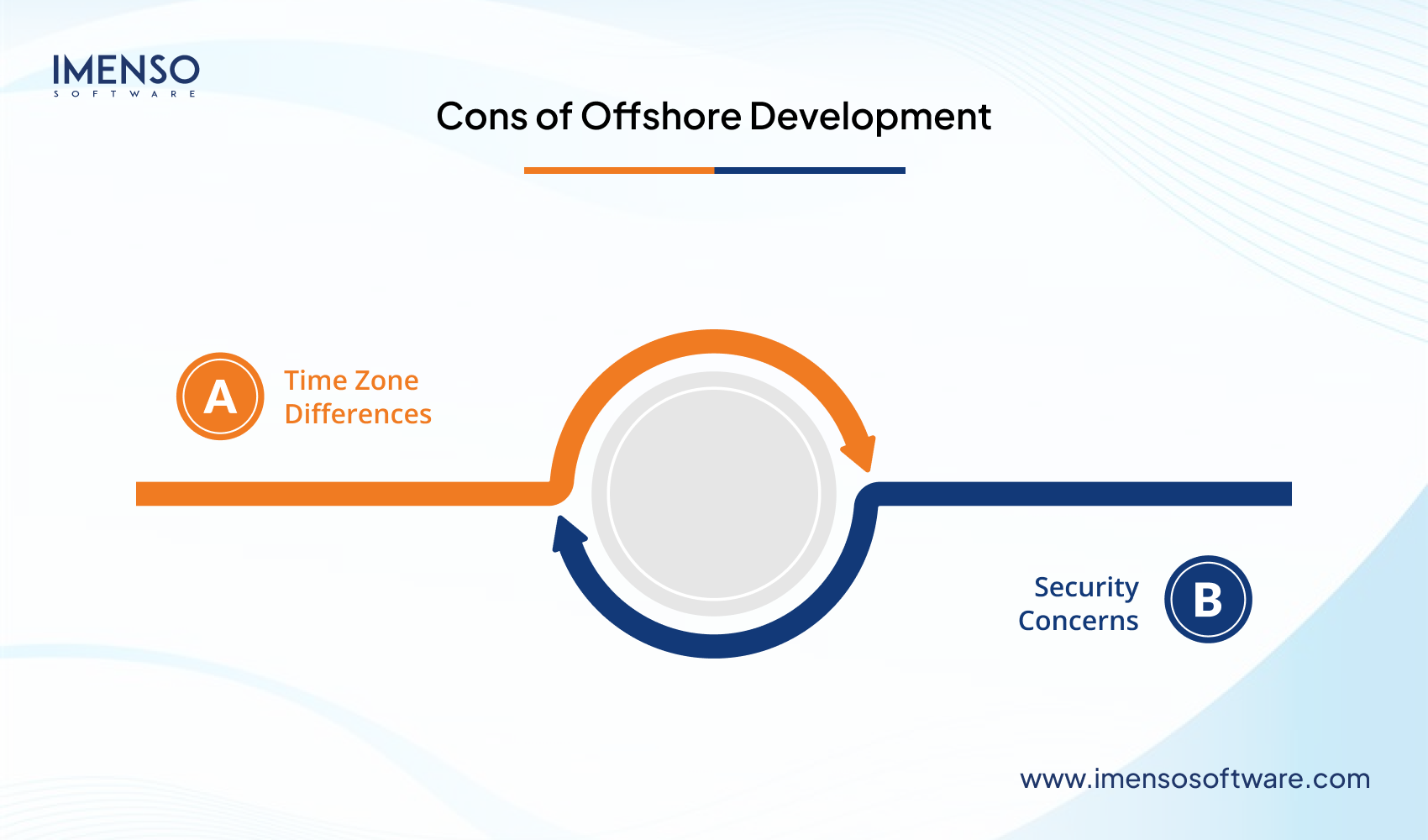
Time Zone Differences
If prompt communication is critical for you, offshore will not be the right choice. Because of greater time zone differences, you have to wait until the shift starts to hear back.
Security Concerns
Since the offshore team is quite distant, there can be some security concerns. A compromise of personal data can wreak havoc. So, it’s critical to sign a legal contract with your provider.
Noteworthy Offshoring Examples
Below are the success stories of three companies that brilliantly used this model.
Before releasing WhatsApp, the company offshored development to Eastern Europe. The offshore talent worked on tasks like design and app creation. It freed WhatsApp’s in-house team for other things like customer support. This strategy allowed WhatsApp to gain massive success.
Google used the offshoring model in 2020. They tapped into the talent in Eastern Europe. Through them, they enhanced the CloudSimple VMware migration solution. Offshoring enabled Google to successfully deploy the project while cutting costs. Now, CloudSimple is an integral part of the Google Cloud.
Lyft
Lyft is a standout example of offshoring. The US-based ridesharing company used Eastern Europe’s engineering expertise. It created a team here in 2021. This team of developers enhanced Lyft’s services. It was due to them that it could achieve so much growth. Today, as the demand for Lyft’s services increases, this team continues to grow.
Nearshore vs. Offshore: Differences at a Glance
| Category | Nearshore | Offshore |
| Real-time Communication | Possible, because of the same or similar time zone. | Not likely possible, because of a 5–12 hour time zone difference. |
| Cultural Alignment | Similar work culture and practice. | More cultural differences |
| English Fluency | Moderate to low level of fluency across Latin America | Fluency varies across continents, from to high |
| Travel Possibilities | 2–5 hour flights, making travel accessible | 8+ hour flights, reducing travel accessibility |
| Data Security | Same or similar data protection laws, which guarantees data security. | Different data protection laws, so the signing of a legal contract becomes critical. |
| Project Spend | $30 to $60 per hour | $20 to $100 per hour |
| Quality of Work | High quality because of better communication and cultural alignment. | Can vary across different regions. |
Offshore vs. Nearshore: A Cost Comparison
| Role | Nearshore | Offshore |
| Senior QA Engineer | $60 to $75 | $30 to $75 |
| Mid Level QA Engineer | $50 to $65 | $30 to $65 |
| Associate QA Engineer | $40 to $60 | $25 to $55 |
| Senior QA Engineer | $55 to $65 | $30 – $65 |
| Mid Level QA Engineer | $45 to $60 | $25 – $60 |
| Associate QA Engineer | $40 to $55 | $20 – $45 |
| Senior Developer | $70 – $85 | $40 – $75 |
| Mid Level Developer | $55 – $70 | $30 – $70 |
| Associate Developer | $45 – $55 | $25 – $55 |
| Lead Developer | $70 – $85 | $45 – $85 |
| DevOps | $60 – $85 | $30 – $80 |
| UX/UI Designer | $50 – $80 | $30 – $75 |
| Scrum Master | $55 – $80 | $45 – $75 |
| Business Analyst | $55 – $70 | $30 – $80 |
| Architect | $75 – $100 | $50 – $100 |
Nearshore vs. Offshore: Factors to Consider Before Deciding
To make the right call, you must consider a bunch of factors. These include:
Proven Center for Outsourcing
Look for nations with a technically proficient workforce. The countries should possess a modern IT infrastructure. Ideally, look for nations with a thriving IT sector. This means that the country has an atmosphere conducive to IT investments. It will likely have fewer trade restrictions as well.
Cost-Effectiveness
Find nations where the cost of living is lower but with high-quality talent. Countries where education is more accessible will be your best choice. In these nations, the talent is unmatched. The great thing is that you can tap into it without draining your budget.
Regulatory Compliance
The country you choose should adhere to international codes of compliance. It must comply with regulations like PCI DSS and ISO 27001, among others. It’s critical to find a nation that meets this criterion. Otherwise, you can incur high penalties, data loss, and reputation damage.
English Fluency
Being unable to communicate because of language barriers hinders your project’s progress. So, choose a nation with a high level of English proficiency. In Asia, countries like the Philippines and India have developers who can speak English fluently. In Europe, Poland and Romania have experts who can easily converse in English.
Security and Laws
Always pick a nation with strong data protection laws. The presence of a comprehensive law system is also critical. To minimize disruptions, choose a nation whose business laws align with your country. As you are outsourcing, you will bear the tax costs. So, pick a nation with fewer tax repercussions.
Relevant Experience
No matter if you are choosing nearshore software development or offshore, the provider must have good, relevant experience. It ensures that they meet your unique project needs. So, look closely at their client reviews and case studies.
Developers’ Skillset
Always choose a team with a diverse range of skills. The team should be capable enough to scale in case your project needs to grow. It’s wise to look into providers that offer teams with complementary skills.
Compliance with Proven Development Standards
You are delegating your project to an offshore provider. Trust is critical to give them such a massive undertaking. So, ensure that they follow a proven delivery framework. Your offshore team should abide by the best Agile practices and use the latest tech stack. They must work with a product-first mindset. Multi-layer quality assurance practices followed by the team further build trust.
Making the Right Choice: Nearshore vs. Offshore Development
We hope that this detailed guide on nearshore vs. offshore will prove helpful. Hiring offshore dedicated developers proves to be a much better choice than nearshore. It gives you more freedom of choice, a humongous talent pool, and is cost-effective. But you may choose nearshore if your project strictly demands it. In any case, researching the best providers is critical to make a sound decision. Use this guide anytime when looking to hire outside talent for software development. You’ll certainly benefit from an informed decision in the form of the best partner.
Frequently Asked Questions
-
- 1. What is the disadvantage of nearshore?
A major con of nearshore is that you have fewer choices. You cannot tap into global tech talent. Startups using this model only have a few options that are limited to nations with less geographical distance.
-
- 2. What are some advantages of nearshore outsourcing compared to offshore outsourcing?
In the nearshore model, you don’t have language or cultural barriers. Collaboration is smoother because the team is within close proximity. This isn’t the case with offshore. Since the team works far away, real-time collaboration does not happen much.
-
- 3. What are the disadvantages of onshoring?
Two key cons of onshoring are high costs and a limited talent pool. You incur more expenses compared to offshoring. The talent pool that you can tap into is also smaller compared to offshore. So, it’s possible that you may not be able to get a specific skillset for your project.
-
- 4. Which is better, outsourcing or offshoring?
Both models cut costs. Startups use outsourcing to leverage broader and more specialized talent. Offshoring’s main use is to access a wider labor market. What is better for you depends on your distinct needs.
Want more information about our services?
Similar Posts

NodeJS Security: Best Practices for Keeping Your Application Safe from Threats
Are you concerned about the security of your Node.js application? Are you aware of the potential risks and vulnerabilities it may face in today’s ever-evolving threat landscape? Protecting your application from malicious attacks and unauthorized access is crucial to safeguarding sensitive data and maintaining user trust. But where do you begin? In a world where […]...

A Detailed Guide on Creating an eCommerce App From Scratch
The way people shop has been drastically changed by ecommerce apps. In recent years, e-commerce has expanded and risen to the top in several consumer sectors. Online stores sell everything from food and apparel to electronics and vehicles. Unsurprisingly, e-commerce is a money maker for the biggest online companies in the globe. The finest customer […]...

Why MERN Stack is the Best Choice for Your Next Web Development Project
In today’s rapidly evolving digital landscape, choosing the right technology stack for your web development project is crucial. A well-rounded stack should offer efficiency, flexibility, scalability, and a supportive community. Among the various options available, the MERN stack stands out as a powerful and popular choice. Comprising MongoDB, Express.js, React.js, and Node.js, the MERN stack […]...








